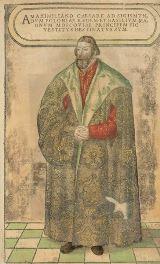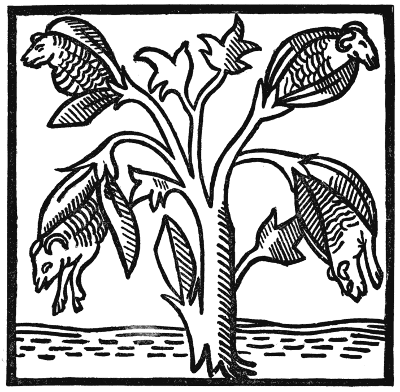Take a close look at this image of the Garden of Eden which appears on the title page of John Parkinson’s Paradisi in Sole. How many of the plants can you identify? Are there any there you don’t recognise?
I was talking about this to an audience recently and explaining that some, like the cyclamen crocus and grapevine were plants which Parkinson probably grew in his garden, alongside relatively newly introduced exotics such as tulips and sunflowers.
But it also included plants, such as the pineapple that he’d never actually seen and strange to report even one plant which we now know never even existed, although it had a long history in travellers tales and still lives on in legend. Although the audience worked out which plant it was none of them had a clue what it really was.
Any ideas?

I’d be surprised if you didn’t work it out. Not many plants grow animals instead of leaves and flowers. Yet that bizarre hybrid of plant and animal was widely accepted as being real and not mythical, partly because of course, at the root of the legend there was a smidgeon of truth.
This is the legendary Scythian Lamb, also known as the Vegetable Lamb of Tartary. It’s what used to be known as a zoophyte, or a creature that was thought to be neither animal nor plant but on the boundaries of both. [Other examples would be the sea anemone and corals]. They crop up regularly in classical, mediaeval and early modern herbals and other medical texts, usually as a way of explaining the origins of strange and unknown plants.
It’s not until the mid-17thc that the whole idea of the zoophyte begins to be treated with some serious scepticism but even Linnaeus gave some credence to the idea, although only in very specific narrow terms. In 1758 his Systema Naturae began a systematic system of classification for animals in the same way that his Species Plantarum had done for plants. He identified what he called the three divisions of the Kingdom of Nature: rocks, plants and animals, “though all three exist in the lithophytes”, the corals. He defined zoophytes as “a composite small organism, with both animal and plant characteristics”. Darwin also used the term, although by his day it was fast becoming obsolescent.
What Linnaeus and Darwin didn’t do was give any credence at all to the reality of the Tartary Lamb.
So what is this weird creature and where does the idea come from?
The mediaeval world loved travellers tales, full of all sorts of marvels and monsters and because few people ever travelled far they were often believed. Far and away the most famous of them was The Travels of Sir John Mandeville, written sometime between 1350 and 1370, which is ostensibly a first-hand account of the journey that began in 1322 of an English knight across the Mediterranean to Jerusalem and then Persia, India and China. It is packed with adventures and descriptions of people and places, marvels, monsters, but the further Mandeville gets from Europe the more outlandish his account becomes.
The Travels were, of course, written long before printing had reached Europe so the text circulated in manuscript. There are around 300 surviving copies, the oldest being in French, and it was translated into at least ten other languages, and in many cases even into dialects. It very soon achieved widespread acceptance as being a reliable story. In 1496 it became one of the first books ever printed in England, while many versions were published in Europe too, so its fame spread further still.
However, as you may already have guessed, Sir John Mandeville almost certainly never existed and instead the work is an anonymous compilation from lots of other travel accounts and then heavily embroidered to make it a 14th/15thc best seller. Scholars have long debated the authorship and sources of The Travels, with several suggesting the author was actually a French cleric. We’ll probably never know for sure, but it’s pretty clear whoever it was had access to a wide array of source material, and particularly to the accounts of Dominican and Franciscan missionaries, which probably implies a monastic library.
Whatever the accuracy of The Travels it does include this reference to a country “beyond Cathay” where “there grows a kind of fruit as big as gourds, and when it is ripe men open it and find inside an animal of flesh and blood and bone, like a little lamb without wool. And the people of that land eat the animal, and the fruit too. It is a great marvel”.
As you can see from these woodcuts the idea of the tree that bore lambs becomes more defined and the creatures clearer in some of the earliest printed editions.
Mandeville then tells the people of Tartary about another zoophyte: “in my country, I said, there were trees which bore a fruit that became birds that could fly; men call them barnacle geese, and there is good meat on them … And when I told them this they marvelled greatly at it.”
This story of the barnacle goose tree comes straight from the narrative told by Odoric of Pordenone an Italian late-medieval Franciscan missionary friar. In 1318 he set off on a journey that took him east to China where he spent 3 years and didn’t get back to Italy until 1329.
Different versions of the story have different ideas about how the geese were created. But it’s the images in Claude Duret’s Histoire admirable des plantes, of 1605 which provide the widest range. On the left is a tree which had seed pods that contained birds, while in other versions they didn’t hatch until the fruit fell to the ground. To make matters more interesting there were also trees where if fruit fell into water they hatched into fish, rather than birds. Sometimes the tree had to be in a state of decay before it released birds and also worms.
However, the Barnacle Goose tree was just one of several zoophytes that Duret included in his book. Others included another magical-sounding tree “borrowed” from an earlier Italian scholar Julius Caesar Scaliger. This came from the island of Cimbubon where “grows a Tree, whose Leaves fallen upon the ground, do move, and creep. It hath Leaves like the Mulberry Tree. They have on both fides that which looks like two little feet; pressed, they yield no Liquor. If you touch them, they flye from you. One of them kept eight days in a Dish, liv’d, and moved, as oft as one touch’d it.” One contemporary thought that this tree resembled ” The SENSITIVE PLANT … which contracts itself, if any one puts his hand to it; and if you pull back your hand, it recovers it self again.” [Sir Thomas Pope Blount, A Natural History Containing Many not Common Observations, 1693]
But of course Duret also included his idea of the Scythian or Tartary Lamb.
We have another account of the Vegetable Lamb this time by Sigismund von Herberstein, a 16thc diplomat for the Holy Roman Emperor, who, travelled throughout much of Europe, Turkey and Russia. After two long trips to Russia he wrote Rerum Moscoviticarum Commentarii (Notes on Muscovite Affairs), published in 1549 which became the main early source of knowledge in Western Europe on Russia. He was a shrewd observer and wherever possible spoke to eye-witnesses as he did in the case of the lamb: “In connexion with these Tartars, I heard a wonderful and almost incredible story from one Dimitry Danielovich, a man who, considering that he was a’ barbarian, was of remarkable dignity and truthfulness. … he had seen in the island a certain seed, somewhat larger and rounder, but not unlike the seed of a melon, from which, when planted, grew up something very like a lamb, of the height of five palms, and that it was called in their language “boranetz”, which signifies a lambkin, for it had a head, eyes, ears, and everything else in the form of a lamb… it bore a very fine wool… He said, moreover, that the plant, — if plant it could be called, — had blood in it, but no flesh; but in lieu of flesh, there was a kind of matter very like the flesh of crabs; it also had horns, not horny like those of a lamb, but covered with a hairy substance resembling horn”.So far much the same as Mandeville’s description. But the rest of Herberstein’s description echoes Duret’s engraving: “Its stem came to the navel, or middle of the belly; it continued alive until the grass around it was eaten away, so that the root dried up for want of nourishment.” In other words the lamb grew rather like a cabbage on a sturdy stem and survived until it had eaten all the available vegetation within its reach. This image and description soon get recycled again, alongside other bizarre phenomena.

Image of Mandrake and its roots from an early 15th Byzantine manuscript, taken from Anna Pavord’s Naming of Names, p.145
The doubts about the Vegetable Lamb begin to creep in a bit later in the 17thc. Sir Thomas Browne, the great experimental philosopher and scientist wrote a book Pseudodoxia Epidemica which sounds a bit heavy and complex but its subtitle tells its purpose much better. It was a series of “Enquirie into very many receive tenets and commonly presumed truths” in which he critically assesses the truth or otherwise of many, up until then accepted “facts”. These include deciding whether “the roote of Mandrakes resembleth the shape of man or …that the roote gives a shreeke upon eradication” Other interesting ideas he investigates are whether “Storkes will onely live in Republicks and free States”, whether “Bayes preserve from the mischiefe of Lightning and Thunder and “That Haniball eate through the Alpes with Vinegar”
In the 1672 edition, near the end of a very long list is a little section about “the Boramez, that strange plant-animal or vegetable Lamb of Tartary, which Wolves delight to feed on, which hath the shape of a Lamb, affordeth a bloody juyce upon breaking, and liveth while the plants be consumed about it.” Browne is very doubtful of that saying “if all this be no more, then the shape of a Lamb in the flower or seed, upon the top of the stalk, as we meet with the forms of Bees, Flies and Dogs in some others; he hath seen nothing that shall much wonder at it.”
The great German physician and botanist Engelbert Kaempfer accompanied a Swedish embassy to Russia and Persia in 1683 and wrote his account of his search for the Vegetable Lamb. He discovered that no-one knew anything about such a creature and concluded rather sharply: “whatever is reported about this plant is pure fiction and fable.”
After that the search was on for the truth behind the myth.
Kaempfer’s collections and papers were acquired by Sir Hans Sloane, the wealthy British patron, collector, and eventually the founder of the British Museum. In 1698 he acquired a cabinet of Chinese curiosities and amongst the various medical instruments and oddities was the strange object in the image above. Whatever it might look like it’s actually a section of the rhizome of a low-growing often prostrate tree fern native to parts of China and to the western part of Malaya. What look like legs are, in fact, the leaf bases of the fern while the rhizome itself was covered with “dark yellowish snuff coloured” down. If you use your imagination maybe you can see why it was thought to resemble a lamb and has been nicknamed the golden chicken fern or woolly fern. It also explains why its botanic name is Cibotium barometz.
Later another fern specimen, this time carefully “modified” to resemble a sheep was debunked by Dr. Philip Breyne, a natural historian from Danzig and friend of Sloane’s. Unfortunately although his analysis was published in the Philosophical Transactions in 1725 it’s in Latin so difficult to quote from easily.
But the story would not die and those fern roots kept re-appearing.
But the truth is often far simpler than all these explorers and scientists imagined. And even Mandeville’s fanciful Travels had a clue. He talks of “the land of Bactry,” where “in that land are trees that beare wol as it were sheep, of which they make cloth.” That might have given you an idea of what the vegetable lamb probably was. Mandeville was actually only citing the great Greek historian Herodotus who writing about India said much the same thing “there also the trees which grow wild produce wool which surpasses in beauty and excellence that from sheep, and the Indians wear clothing obtained from these trees.”
But the best account comes from Julius Pollux, a 2nd century AD Greek scholar in his Onomasticon, according to Mick Hartley [I can’t find the text translated and in print] says, “among the Indians a sort of wool is obtained from a tree. The cloth made from this wool may be compared with linen, except that it is thicker. The tree produces a fruit most nearly resembling a walnut, but three-cleft. After the outer covering, which is like a walnut, has divided and become dry, the substance resembling wool is extracted, and is used in the manufacture of cloth.”
The reality underlying all these myths was of course the plant Gossypium better known by its product: Cotton. There are four main sorts, two of which would have been known to the classical world. Levant cotton, [Gossypium herbaceum] which is native to Arabia, and also sub-Saharan Africa, and tree cotton [Gossypium arboreum], which comes mainly from the Indian subcontinent where it was bought into cultivation for textiles around 4000 years ago. It grows between one to two metres in height and when you look at the pods you can see how the legend arose, especially when the description of the plant was passed on from person to person to person to person getting gently modified in the process so that the idea of wool growing on trees could be conflated with sheep growing on trees.

After the myth was busted the Vegetable Lamb continued to make occasional appearances in literature but it returned to fame when Henry Lee , a Victorian naturalist, decided to investigate the story properly. He hunted down many, but by no means all, of the accounts and images, before writing it up at length as The Vegetable Lamb of Tartary: a Curious Fable of the Cotton Plant in 1887.
The most often reproduced image of theLamb is the one below, often said to be “by Mandeville”, “from Mandeville” or “after Mandeville” and usually dated around 1350-1370. In fact it’s a copy redrawn and modified by Lee for his book and taken from the 1481 version of The Travels printed in Augsburg [see above].
The tale of the Scythian Lamb, Barometz or Vegetable Lamb of Tartary still continues to unfurl, because the poor fake beast has, according to Wikipedia, recently re-appeared in modern form in the fantasy world of manga comics and video games [all of which are outside my expertise and research skills!]. Maybe someone younger can tell me all about it!
But at least now you know why cotton wool came to be called cotton wool!
For more information there are several other blogs which have looked at The Tartary Lamb and from different points of view…. including Charles Moseley’s The Marvels, the Mystery, the Man: Reflections on re-reading Mandeville’s Travels; Caroline Murray’s post about it in her wonderful quirky Professor Hedgehogs Journal; and Fabrizio Baldassari’s The Vegetable Lamb of Tartary: Renaissance Philosophy, Magic, and Botany
























You must be logged in to post a comment.